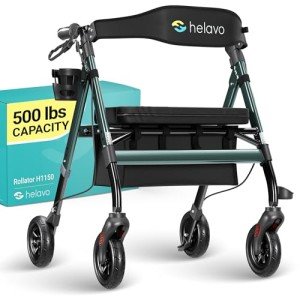5 Clarifications On Bariatric Walker

Understanding Bariatric Walkers: A Comprehensive Guide
As the population ages and the frequency of weight problems boosts, the demand for adaptive mobility help, such as bariatric walkers, has actually increased significantly. These specialized walkers are designed to support heavier people, offering security, stability, and mobility. In this post, we will explore the numerous aspects of bariatric walkers, including their benefits, features, types, and factors to consider for usage, ensuring you have a comprehensive understanding of this essential mobility aid.
What is a Bariatric Walker?
A bariatric walker is a type of mobility aid specifically developed to support people who are overweight or obese. Unlike Secure 4-Wheel Walker , bariatric walkers are built with reinforced materials and features to supply increased sturdiness, stability, and weight-bearing capacity. They are an important tool to enhance mobility, self-reliance, and security for people undertaking rehab or those with persistent health conditions.
Secret Features of Bariatric Walkers
Bariatric walkers come equipped with different features tailored to the requirements of larger individuals. Here are some of the essential features one can expect:
| Feature | Description |
|---|---|
| Weight Capacity | Usually supports in between 300 to 600 pounds |
| Frame Construction | Made from robust materials like aluminum or steel |
| Adjustable Height | Height can be adapted to accommodate different users |
| Wide Base | Larger base for enhanced stability and balance |
| Hand Grips | Padded, ergonomic grips for comfort |
| Wheels | Can have two or four wheels for mobility choices |
| Accessories | May consist of a seat, storage basket, or tray |
Types of Bariatric Walkers
When considering a bariatric walker, it's crucial to understand the various types readily available:
Two-Wheel Bariatric Walker
- Features a lightweight frame with 2 front wheels.
- Suitable for users requiring minimal assistance while walking.
Four-Wheel Bariatric Walker
- Provides more mobility and often consists of a seat.
- Advised for users requiring more support and the choice to rest.
Rolling Walker
- Comparable to four-wheel walkers but generally includes a braking system.
- Offers simpler navigation for larger individuals.
Dual-Function Walkers
- Integrates features of conventional walkers and rollators.
- Ideal for users looking for flexibility in mobility alternatives.
Walker with Seat
- Allows users to rest throughout walks, an essential feature for those with restricted endurance.
Advantages of Using Bariatric Walkers
The advantages of utilizing a bariatric walker extend beyond mobility. A few of the most significant advantages consist of:
- Increased Safety: With tough building and improved stability, bariatric walkers decrease the risk of falls and injuries.
- Improved Mobility: Users can restore independence, moving about their homes and communities more conveniently.
- Enhanced Confidence: With the capability to move safely, people typically experience a boost in self-esteem and self-confidence.
- Assisting Rehabilitation: Essential for physical therapy and rehab, helping with movement and healing.
- Weight Distribution: Designed to support a larger weight distribution successfully, they promote much better posture and balance.
Factors to consider When Choosing a Bariatric Walker
Choosing the ideal bariatric walker is crucial for guaranteeing safety and convenience. Here are some vital factors to think about:
- Weight Capacity: Always inspect the optimum weight limit to make sure the walker can accommodate the user's weight safely.
- Height Adjustability: Select a walker with adjustable heights to cater to the user's stature.
- Foldability: Consider a foldable walker for easy transport and storage.
- Wheel Size and Type: Depending on the walking surface area, larger wheels may help with smoother motion over bumps and shifts.
- Storage Options: Additional features like baskets or trays can be important for carrying individual items.
Frequently Asked Questions about Bariatric Walkers
Q: How do I know if a bariatric walker is best for me?A: Consult a healthcare professional or physical therapist, who can assess your needs and suggest the most appropriate mobility aid. Q: Can bariatric walkers be used outdoors?A: Yes, lots of bariatric walkers are developed for indoor and outdoor usage, especially those with larger wheels. Q: How much do bariatric walkers generally cost?A: Prices can differ widely, typically varying from ₤ 100 to ₤
400, depending upon the features and brand name. Q: Is assembly required
for bariatric walkers?A: Some models come pre-assembled, while others might need basic assembly. Constantly check the item description. Q: How do I maintain my bariatric walker?A: Regularly check
the walker for loose parts, guarantee wheels and brakes operate properly, and tidy it frequently to keep it in optimum
condition. Bariatric walkers play a pivotal role in boosting mobility and promoting independence for much heavier people. With numerous styles, features, and factors to consider, it is necessary to discover the
right walker that fits the user's particular requirements. By comprehending the info laid out in this guide, users and caregivers can make informed choices to assist in much safer and more comfortable mobility. As individuals look for the best options for mobility challenges, the bariatric walker remains a reliable and vital alternative for promoting an active and independent way of life, paving the
way for improved quality of life.

